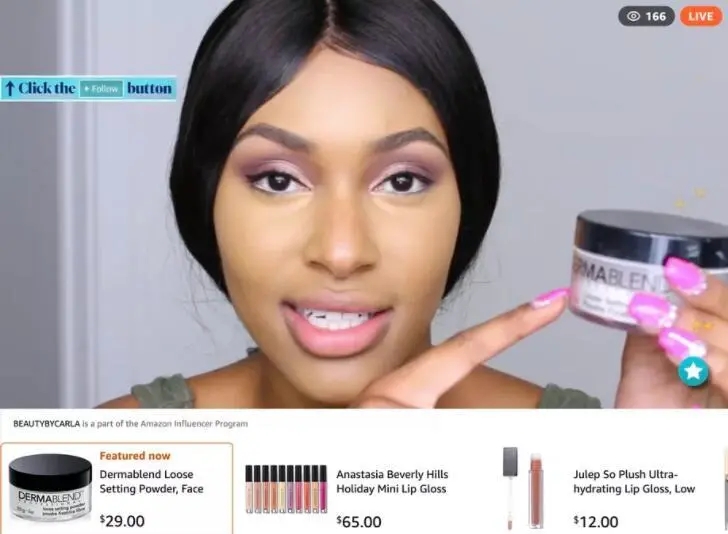Free Fire: Becoming the Hottest Tactical Competition Game in the US After Its Success in Southeast Asia and Latin America
Launched 3 years ago, "Pokemon Go" is still going strong!
Free Fire Shows Strong Momentum, with Its Revenue Overtaking PUBG Mobile in a Single Market for Q1 2021
Slay the Spire: Deck-Building Mastery Unleashed
How Much do you Know About the Game Minecraft?
Supercell‘s sixth mobile game "Rush Wars" is now in beta
Live shopping has been on the rise for a while in China, and it's becoming the next frontier for influencers to gather around. Now it's booming in the United States, with tech giants like Amazon, Instagram and Google all wanting to get a piece of this nascent field.

Carla Stevenné looked nervous as she took part in the first live broadcast. As a member of the Amazon Live Influencer testing team, she needed to find out what to sell and figure out how to schedule the time assigned to her. Stefani has never tried to sell a product in live broadcast before, let alone spend 60 minutes talking to himself on camera. She looks around her room and a few things stand out, including a waterproof Bluetooth speaker, Crest 3D Whitestrips and a Bluetooth karaoke machine.
"I kept looking at the time for 15 minutes and I thought, 'Oh my God, it's going to be an hour in 45 minutes and I don't know what I'm going to do,'" Steaveni said. Few people watched Stefani's first live broadcast, but after more than 200 attempts, she says an hour of video is far less daunting than she thought, and hundreds of people can watch it at the same time.
2020 is an important year for American tech companies to enter the live shopping arena. Amazon launched Amazon Live for influencers in July, and Instagram and Facebook launched Live shopping in August. Google's R&D department, Area 21, also launched Shoploop, which is not live but offers shoppable stories.
At the same time, smaller startups are continuing their efforts to make live shopping the future of retail. On each platform, live shopping ends up looking like a modern upgrade of TV shopping (QVC), but with the rise of influencers and its replacement of celebrities, they can also get a slice of sales.
Tech companies have good reason to believe that live shopping could thrive in the United States, given its size in China. Statistics show that 60 million people watched live videos of shopping in March, an increase of 126 million compared with June last year. Even Kim Kardashian West also teamed up with Chinese influencers on live shopping streams, selling 15,000 bottles of perfume almost immediately.
Layla Amjadi, head of shopping product at Instagram, said: "Live shopping is really a magical, two-shot way of discovering and thinking. It can even be boiled down to a form of entertainment. Not only can you find the product, but you can also hear some introduction about it, see it with your own eyes and even see the effect."
Moreover, with the closure of retail stores related to COVID-19 outbreak, the transition to online shopping will only intensify. Live shopping could be the future of retailing, especially when coupled with the tentacles and enthusiasm of influencers.
When Nikita Dragun, a YouTube makeup artist, hosted a live shopping event on Instagram, 40,000 people tuned in, Mr. Anjadi said. Across the entire segment, 5,000 items were added to the shopping cart, she said. And sales are also a boon for Ms. Dragon, because she only sells only her own branded products.
"There's a lot of potential demand for brands and products from people you look up to and want to emulate," says Mr. Anjadi. However, the creator can appear on Instagram in multiple identities. They can demonstrate marketing or sales skills, and increasingly they tend to do both."
Influencers, who do not sell their own products, can make money through affiliate links, depending on the platform. Amazon accepts affiliate links for live events, while Instagram requires brands to register with Facebook before launching. Currently, only brands can make money on Instagram, with Facebook taking a cut of the proceeds from the deal.
Lauren Beitelspacher, associate professor of marketing at Babson College, said it was vital to the success of live shopping and that influencers had earned the trust and admiration of their fans, which made them the perfect sales force. "This kind of live shopping with influencer is basically like shopping with friends or people you really aspire to be with, and I think this trend is only going to grow," she said.
Communication between influencer and the audience is a major part of live shopping. Just like Stevenney’s live stream, viewers can learn more by asking questions. Facebook highlights the interactive aspect of live shopping in its best practice guidelines. Responding to each comment, this guide says, helps "turn them into new clients."
However, not every creator achieved great success. Google hired Hélène Heath to create beauty content for the release of Shoploop, but she didn't make any money by including affiliate links in her nine videos. Nor has she produced more videos since the original deal closed.
Ms. Stefani said that thanks to her success with Amazon's Live Shopping service, she can focus on live streaming, but she still has to buy everything herself and hopes to get cash back from sales. Heath still sells products on her Instagram through traditional brand posts and affiliate links. "There's definitely a balance to be struck between sounding like a friend who really likes the product and trying to get your audience to buy it so you can make a little bit of money out of it," she said.
When all the influencers come online, the impact of product marketing may not stop.